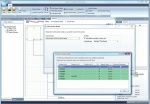
Marc Diaz, Country Manager for Panasonic, looks at what’s new in VRF technology
Product development and advances in technology are certainly playing their part in driving the continued demand for VRF systems. The result is VRF technology which delivers not only excellence in sustainability, energy efficiency and performance but also provides consultants, contractors and their customers with modern and stylish products for commercial applications.
Highly efficient VRF
At the heart of this focus is energy efficiency. In short, improving the efficiencies of current VRF technologies makes it easier for systems to pass through on SBEM (Simplified Building Energy Model) calculations while also complying with Part L of the Building Regulations. This drive towards improved efficiency is bringing fresh designs in heat exchangers, fans, fan motors and compressors to VRF units, such as Panasonic’s new VRF ECOi series. These component improvements are combining to deliver much better Seasonal Energy Efficiency Ratios and Co-efficient of Performance (SEER and COP) calculations used in the SBEM programme.
Other manufacturing changes include the addition of hi-COP options alongside standard efficiency models. Standard mode offers the highest capacity while still delivering excellent efficiency. Switching to hi-COP mode delivers exceptional efficiency and low running costs with a slight reduction in capacity. When comparing the two, a COP 4.57 for an 8HP unit can be achieved in heating mode against an average COP of 4.35 under the same conditions for a hi-COP unit.
Specification
Greater choice is making VRF specification easier. For example, Panasonic’s new VRF ECOi series now offers units in capacities from 4 to 20HP (4, 8, 10, 12, 14, 16, 18 and 20HP) alongside a modular option which allows three outdoor units to be connected together to form one system of up to 60HP.
Meanwhile, the latest products on the market allow up to 64 indoor units to be connected as part of a system. This ensures easy VRF specification on large commercial, leisure and public sector projects, such as offices, hotels, hospitals and schools.
At the other end of the market, smaller, high performance units are coming through. This trend is opening up the opportunity for contractors to grow business in the residential and light commercial sector, where the available installation space for an outdoor unit may previously have prevented VRF specification.
Panasonic is dedicated to the development of technology which delivers excellence in sustainability, energy efficiency and performance, providing the market with modern and stylish products for residential, commercial and public sector applications.
GHP (gas-driven heat pump) technology is a great example of this approach. It provides commercial building owners and energy managers with a proven alternative to traditional 3-phase air conditioning solutions. GHP can also contribute to a reduction in the burden on the UK’s power supply network, by making use of the existing gas supply infrastructure. It’s an air conditioning alternative that deserves proper consideration in an increasing number of commercial applications.
True versatility
By providing a choice of gas based systems alongside electric powered VRF systems, manufacturers are offering the market true versatility. Using gas to drive the compressor overcomes many of the problems associated with obtaining a suitable electricity supply. A 3-phase supply is available in only about 60% of UK commercial properties and is very expensive to install.
Large air conditioning systems cannot be run from a single-phase supply. The electrical power consumption of gas powered systems is kept to a minimum since outdoor units only require a single phase power supply to run auxiliary items such as controls and fans systems, with levels as low as 0.7kW usage possible.
Efficiency is still a key driver. For example, our new ECO High Power units feature a compressor and a generator, driven by a gas engine, with the generated electricity used for the fan motor and the cooling water pump. This means we can substantially reduce the power consumption of the outdoor unit, using only 1% of the power consumption of a conventional VRF system. Improvements in engine efficiency have been achieved by the reduction of charge and exhaust resistance (15% reduction of the displacement). Thanks to improvements in the heat exchanger design, system efficiency is further enhanced by optimising the refrigerant distribution.
Software
At the same time, software solutions are supporting product innovation, helping to make VRF specification much quicker and easier. And with the advent of an iPad app for simple sales and specification tasks, information is readily available. Recently released software programmes available to registered installers via our website allows contractors to design and size systems very quickly. Typically, these programmes will continuously check system designs for piping limitations in terms of height and length, capacity matches between indoor and outdoor units, correct piping and correct wiring.
Correction factors are automatically applied to indoor unit capacities, depending on height differences, piping lengths, indoor/outdoor capacity ratio and design conditions. This can even be done for each room. Based on configuration and piping lengths, these latest software programmes will also calculate any additional amounts of refrigerant that may be required.
As a result, contractors using products such as Panasonic’s VRF Designer, can now develop projects more rapidly and even create several different system designs, if required, within one project.
Ease of installation
Specification is one thing. Installation is quite another. But here innovation is also apparent. VRF systems increasingly offer greater benefits to the contractor including smaller footprints for outdoor units, longer pipe runs, and a greater variety of smaller and shallower indoor units.
